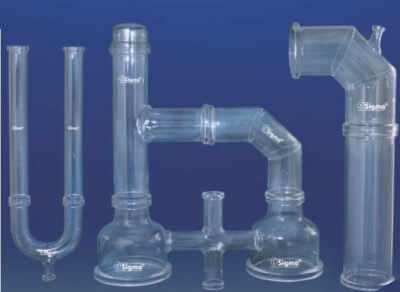Glass and scientific advances have gone hand-in-hand throughout history. For centuries the knowledge and art of scientific glass blowers have been integral to the development of chemical, pharmaceutical, electronic and physics research. Some notable examples include Galileo’s thermometer, Edison’s light bulb, and the vacuum tubes of early radio, TV and computers. The qualities of glass and the skills of those who fashion it has contributed more recently to the advances in industries and research in fiber optics, lasers, atomic and subatomic particles, communications and semiconductors.
Glassware is found in abundance in laboratories and comes in all shapes and sizes. Though it has become preferable in recent years to substitute glass vessels for cheaper, more durable and less fragile plastic materials, some substances and experiments or applications still require the use of glassware. The reasons for these are manifold. Firstly, glass is relatively inert, meaning it will not react with the chemicals or substances placed inside and thereby upset or skew the results. It is also transparent, allowing for easy monitoring, and heat-resistant, allowing for high temperatures. Furthermore, it is easy to shape and mould into any form required.
Science and glass, a partnership for the ages
Glass has been an integral part of science and the development of science for a very long period now. Glassware in the form of beakers, petri dishes, vials, burettes and cylinders among others has always been a part of even the smallest laboratories. This is because of the unique inert qualities that allow chemical substances to be placed inside it. However, not all glassware is equal. There are different materials used in making laboratory glass such as quartz, soda lime, borosilicate and actinic among others. Let’s have a look at some of the varied types of glasses that are a big part of the laboratories and play a big part in the constant development of science.
Quartz Glass: Silica glass is another name for lab ware made from this material. These are among the most uncompromising equipment found in a laboratory. They are created at high temperatures of 2,000C by melting sand. This is normally transparent with superior thermal and optical properties. If you are conducting experiments with wide temperature differences, then this is the ideal glass for you. It has a low coefficient of thermal expansion, which makes it very suitable to be used in any temperature. There is a wide range of laboratory ware available in this material including joints, tubes, flasks, beakers, cuvettes and crucibles.
There are a number of areas where you can easily use this glass. This can be used for volumetric measuring to give proper results. It can also be used to hold and store samples or chemicals. Another area of functionality is mixing chemicals for experiments and preparing solutions. You can also use this in various other lab processes such as spectrophotometry, distillation, contained chemical reactions and chromatography. This material has unmatched thermal properties that are far superior to other glass materials. It can be heated till 15000C, and then dunked in cold water without a crack. This makes it safe to be used for experiments involving massive temperature changes. It can be used to heat materials such as gasoline as well.
Soda Lime Glass: This glass is extremely fragile and has a low melting point. It is almost impossible to repair and does not have a high thermal shock resistance. You might wonder about the functionality of this ordinary glass in laboratories. The answer lies in its affordability. It is lower cost and can be easily made. Hence, it is used for lab equipment that is required in abundance such as pipettes, measuring cylinders, disposable test tubes and volumetric flasks. Here are some properties of this glass that makes it useful in laboratories. Soda lime glass is an extremely chemically stable type of glass. It is also durable, which makes it workable for long periods of time. Compared to other glasses that can be used for scientific purposes, soda lime glass is also a cheaper and affordable option.
Borosilicate Glass: Borosilicate glass is among the most common types of glass found in laboratories and is used in beakers, vials, test tubes, flasks etc. This material has a low expansion that makes it suitable for a wide variety of laboratory applications. It has a high resistance to chemical attacks and a very low coefficient of expansion. However, there are some substances that this glass material is not inert to. These substances are hydrofluoric acid, strong caustic solutions and phosphoric acid. Why borosilicate glasses are such a big thing in scientific laboratories is because it is an extremely durable glass and its properties help them withstand high temperatures very easily. They have a very low coefficient of expansion and have the ability to withstand high agitation and thermal stress.
While these are some different types of glasses used in laboratories for scientific purposes, there is a lot more that you can learn and explore because science and the use of glassware in science is a very deep topic that one can dwell upon.
